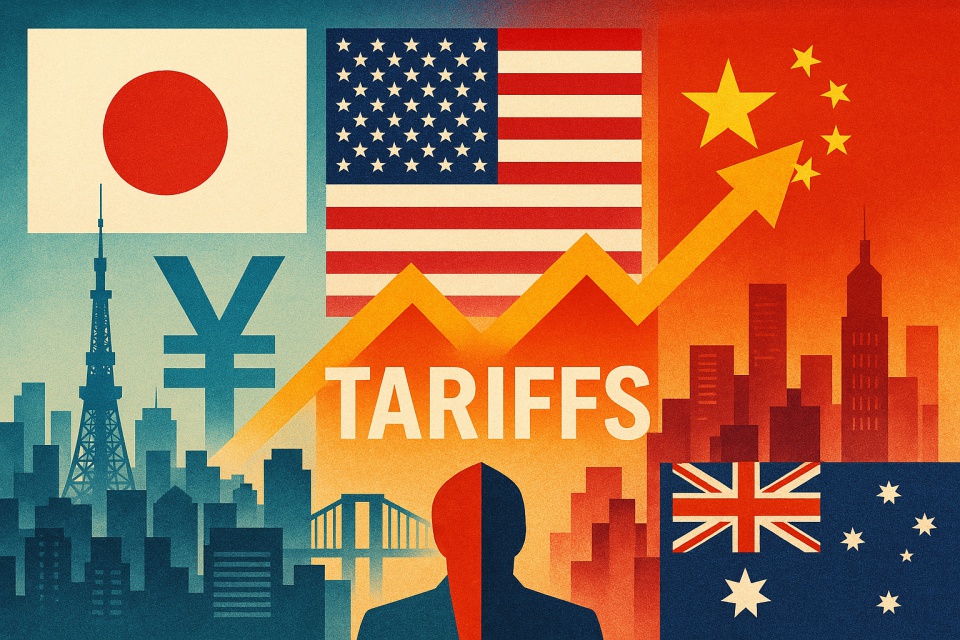The global forex market is once again at a critical juncture, with the Japanese yen and the Australian dollar facing significant crosswinds from three major policy fronts.
Japan’s latest Tokyo CPI data reignited speculation of a long-awaited rate hike from the Bank of Japan, a potential historic shift after years of ultra-loose policy. Meanwhile, President Donald Trump’s renewed tariff threats — this time linked to the TikTok debate — have reintroduced uncertainty around U.S.-China trade relations. Simultaneously, China’s recent stimulus moves aim to support domestic demand and cushion global markets, particularly commodity-linked currencies like the Aussie.
As these three policy vectors — monetary tightening in Japan, geopolitical trade friction in the U.S., and economic stimulus in China — collide, USD/JPY and AUD/USD traders must prepare for heightened volatility and potential directional shifts.
This article breaks down the key developments, analyzes intermarket dynamics, and highlights scenario-based strategies to navigate this complex macro environment.
Key Headlines and Market Reactions
📈 Tokyo CPI Surprises to the Upside
On March 28, Tokyo’s core CPI rose to 2.4% YoY, up from 2.2% in February, exceeding market expectations. While headline inflation remained steady at 2.9%, the increase in underlying inflation added fuel to expectations of a potential BoJ rate hike in July. The market’s initial reaction saw USD/JPY dip from 151.00 to a session low of 150.76, before stabilizing as traders digested the broader implications.
🚢 Trump’s Tariff Proposal Rattles Markets
The BoJ’s Summary of Opinions released on the same day revealed deep concern about growing downside risks tied to U.S. trade policies. President Trump’s suggestion to tie tariff concessions to TikTok’s divestment raised red flags in both political and economic circles. Traders began pricing in renewed geopolitical tensions that could complicate central bank policy outlooks.
🏗️ China’s Stimulus Efforts Provide a Backstop
While risks from Japan and the U.S. weighed on market sentiment, China’s recent stimulus announcements — including fiscal and monetary measures — helped stabilize commodity-linked assets. Analysts noted that stronger domestic demand in China could support AUD/USD, even amid rising trade friction. Oil prices, too, found support, with Brent crude bouncing off the $70 mark, partly driven by Chinese data and stimulus expectations.
Together, these headlines shaped a choppy but crucial trading day for FX markets, with volatility likely to persist as traders await the next round of U.S. inflation data (PCE) and signals from the Fed.
Fundamentals Behind the Moves
To fully understand the recent FX market dynamics, it’s essential to unpack the policy narratives behind each of the three key regions—Japan, the United States, and China. Each represents a distinct but interconnected vector shaping currency flows and trader sentiment.
🇯🇵 Japan: Inflation Pressures and the BoJ’s Delicate Balancing Act
For the first time in years, the Bank of Japan (BoJ) is facing credible pressure to tighten policy. The Tokyo CPI print reinforced market expectations that a rate hike could come as early as July. However, the BoJ remains cautious. In its latest Summary of Opinions, policymakers cited “heightened global uncertainties,” particularly those stemming from U.S. policies, as a reason to proceed carefully. This reflects a BoJ that’s still wary of external shocks undermining fragile domestic demand, even in the face of persistent inflation.
🇺🇸 United States: Tariff Politics and Monetary Uncertainty
President Trump’s proposed linkage between tariff relief and TikTok divestment signals a potential escalation in economic nationalism. While not yet official policy, the rhetoric has rekindled fears of a new trade war cycle. Simultaneously, the Fed remains data-dependent, with upcoming PCE inflation and personal income data expected to shape its near-term rate path. A hotter-than-expected reading could push back rate-cut expectations, boosting the dollar — but layered on top of tariff risk, this creates a two-sided volatility scenario for USD-based pairs.
🇨🇳 China: Stimulus Aims to Cushion Global Risk Assets
Facing sluggish demand and property sector fragility, Beijing has ramped up fiscal and monetary support. While details remain fluid, the policy mix signals an intent to stabilize consumption and buffer against external shocks. For FX markets, this creates a supportive floor for risk-sensitive assets, including the Australian dollar, which is heavily tied to Chinese growth. China’s stimulus also underpins commodities such as oil, giving the global risk environment a more complex, two-speed dynamic: geopolitical risk from the U.S. versus economic support from China.
These fundamentals help explain the push-pull mechanics in FX pricing, especially in USD/JPY and AUD/USD, where macroeconomic signals now clash with political noise, creating conditions ripe for breakouts — or breakdowns.
✅ FX Fundamentals by Country
| Country | Key Policy Force | Market Implication |
|---|---|---|
| Japan | BoJ may hike rates amid rising inflation, but remains cautious due to external risks | Potential JPY strength, but timing and scope remain limited |
| United States | Trump’s tariff rhetoric and inflation-driven Fed outlook add complexity | Elevated USD volatility tied to both trade policy and inflation data |
| China | Stimulus measures to boost domestic demand and stabilize commodities | Supportive for AUD and global risk sentiment; may cushion downside pressures |
✅ FX Pair Fundamentals Overview
| FX Pair | Bullish Drivers | Bearish Drivers |
|---|---|---|
| USD/JPY | Strong U.S. economic data, delayed BoJ tightening | Hawkish shift by BoJ, trade war escalation, safe-haven demand for JPY |
| AUD/USD | China stimulus, global risk-on sentiment, commodity support | Rising U.S. yields, tariffs on China, weak global demand |
| USD/CNH | Trade tension escalation, strong U.S. dollar, Fed delay on rate cuts | PBOC intervention, improving Chinese data, easing inflation |
Market Crosscurrents: Intermarket Connections
In today’s macro environment, foreign exchange markets are no longer moving in isolation. Instead, they are increasingly shaped by cross-asset feedback loops, where movements in commodities, equities, and crypto assets interact with FX flows in real time.
🛢️ Commodities: Oil and Australia’s Trade Exposure
China’s stimulus efforts, aimed at propping up internal demand, have helped to stabilize Brent crude oil prices near the $70 support level — a critical floor repeatedly tested this year.
Given that Australia is a major exporter of commodities, especially to China, this resilience in oil prices indirectly supports the AUD/USD pair. However, if U.S. tariffs escalate, threatening global trade and Chinese industrial demand, the positive impact on commodities and AUD could quickly reverse.
💰 Bitcoin and Risk Appetite
Risk sentiment is also reflected in the crypto space. Several analysts have noted that Bitcoin’s recent strength — with calls for $250K+ in the next macro cycle — is underpinned by global liquidity tailwinds, including China’s stimulus and the Fed’s tapering of QT.
While Bitcoin and AUD/USD do not move in perfect sync, their correlation tends to increase during macro reflation phases, offering indirect signals for risk-on or risk-off positioning.
📈 Equities and Yield Sensitivity
U.S. equities remain highly sensitive to both Fed rate expectations and political noise around tariffs. A sharp drop in equity indices could drive safe-haven demand for the yen, particularly if coupled with dovish signals from the Fed.
In contrast, a stable or rising equity market alongside firm inflation could push U.S. yields higher and reinforce the USD/JPY uptrend.
🔁 Summary: Intermarket Forces in Motion
| Asset Class | FX Impact |
|---|---|
| Oil (Brent) | Supports AUD if above $70; risk if demand slows |
| Bitcoin | Proxy for global liquidity & risk appetite |
| U.S. Stocks | Risk sentiment gauge; equity sell-off may boost JPY |
The convergence of these intermarket dynamics means FX traders must monitor more than just central banks or economic data. Staying ahead of global crosscurrents is key to anticipating major currency shifts.
Key Watchpoints for Traders
With macro forces pulling markets in opposing directions, FX traders need to remain laser-focused on data releases, policy commentary, and technical levels that could trigger high-volatility moves. Below are the key elements to monitor in the coming sessions:
🔎 USD/JPY: Data-Driven and Politically Sensitive
| Factor | Why It Matters |
|---|---|
| Tokyo CPI / BoJ statements | Any signs of hawkish shift may accelerate yen strength. |
| US Core PCE & Personal Income | Higher-than-expected inflation could delay Fed rate cuts, supporting USD. |
| Trade war headlines | Renewed tariff tension could spark risk-off flows, boosting safe-haven JPY. |
| Technical resistance | Watch the 152.00 zone, a key ceiling from February; support at 149.35. |
🦘 AUD/USD: China-Linked and Yield-Sensitive
| Factor | Why It Matters |
|---|---|
| Chinese stimulus developments | Continued support may boost AUD via improved commodity outlook. |
| US economic data & Fed guidance | A stronger USD could drag AUD/USD lower, especially below 0.62500. |
| Risk sentiment | Equities and crypto rallies typically help AUD in risk-on phases. |
| Technical watch | 0.63623 (50-day EMA) is a bullish threshold; 0.62000 serves as key downside marker. |
📍 Other Considerations
- USD/CNH: Closely tied to geopolitical risks and Chinese capital flows. Increased tension could see the yuan weaken, influencing broader EM sentiment.
- Equity markets & volatility indices (VIX): Spikes in volatility can reverse trends quickly, particularly for JPY and AUD pairs.
- Fed commentary: Any deviation from the expected rate path could cause ripple effects across all USD pairs.
In this increasingly complex environment, traders must adapt quickly, manage risk proactively, and stay informed across asset classes. The days of trading FX based on just one economic indicator are long gone.
Market Sentiment: What Are Traders Saying?
The real-time pulse of the market can often be found not just in charts and headlines, but in the conversations happening on social platforms like X (formerly Twitter). Here’s a curated look at how seasoned traders and macro commentators are reacting to the latest developments.
🇯🇵 Tokyo CPI & BoJ Rate Hike Speculation
Looks like Japan has a budding inflation problem. Terrible demographics and a debt to GDP that would make Zimbabwe blush. At what point does this become a major problem? They can’t raise rates very much or risk bankrupting the government.
📝 Takeaway: Market participants are skeptical about how far the BoJ can tighten, even with rising CPI, due to structural issues like debt and demographics.
🇺🇸 Trump’s Tariff Proposals Stir Controversy
CEOs were baffled by the desire to both impose tariffs — but also tell car companies they couldn’t raise prices… So who pays for that? Us?
Libertarian capitalism is telling other people how to do capitalism lol. Nothing like sweet coercion.
📝 Takeaway: There’s deep skepticism among traders and analysts over the economic logic behind Trump’s proposed tariff-control mix. Many fear this could spark policy uncertainty and weigh on business sentiment.
🇨🇳 China’s Stimulus & Global Liquidity Expectations
Real Bitcoin hodlers know $250k+ is the next big leg up as global M2 liquidity increases from key developments like China’s stimulus and now the Fed winding down QT.
Crude found a floor below $70 thanks to some positive data from China, stimulus announcements, and proposed U.S. sanctions on Venezuela
📝 Takeaway: Traders are watching China’s fiscal moves closely — not only for AUD/USD signals, but as a barometer for broader global risk appetite and liquidity trends, including in crypto and oil markets.
🧠 Summary of Trader Sentiment
| Topic | Sentiment |
|---|---|
| BoJ & CPI | Cautious optimism, but concern over structural limits |
| Trump Tariffs | Widespread skepticism, viewed as market-negative |
| China Stimulus | Generally bullish, seen as supporting risk assets |
| Risk Environment | Fragile; traders on alert for volatility spikes |
These conversations offer invaluable insight into how market participants are positioning themselves and interpreting macro risks — often in more nuanced ways than official statements or data releases reveal.
Scenarios and Strategic Outlook
With multiple macro variables in motion — from central bank positioning to political risk and global stimulus — FX markets are facing a range of potential outcomes. Below is a breakdown of the most probable scenarios and how they could affect key currency pairs, along with actionable insights for traders.
🔺 Scenario 1: Sticky U.S. Inflation + Hawkish Fed
Conditions:
- Core PCE and personal income/spending data come in hot
- Fed pushes back against rate cut expectations
Market Implications:
- USD/JPY breaks above 152.00
- AUD/USD drops below 0.62500 due to widening yield gap
- Risk-off in emerging markets and pressure on CNH
Strategy:
- Buy USD/JPY on breakout with stop below 151.00
- Short AUD/USD targeting 0.6150
- Consider long USD/CNH as a hedge against EM stress
📉 Scenario 2: Softer U.S. Data + Geopolitical Tensions Rise
Conditions:
- Weak PCE, consumer spending slows
- Trump escalates trade rhetoric or U.S.-China relations deteriorate
Market Implications:
- Safe haven flows into JPY; USD/JPY moves toward 149.35
- AUD/USD weakens due to risk aversion and China exposure
- Equities and commodities sell off
Strategy:
- Buy JPY crosses on dips (USD/JPY, EUR/JPY)
- Avoid high-beta trades like AUD/JPY
- Consider gold or short equity index hedges
🚀 Scenario 3: China Stimulus Gains Traction
Conditions:
- Beijing announces additional fiscal/monetary easing
- Chinese data shows signs of stabilization
Market Implications:
- AUD/USD rallies above 0.6360 (50-day EMA)
- Risk-on flows support equities, BTC, and oil
- CNH stabilizes or strengthens slightly
Strategy:
- Long AUD/USD with tight stop below 0.6250
- Long AUD/JPY for high beta risk play
- Monitor Chinese equities and copper as leading indicators
🧩 Tactical Guidance Summary
| Scenario | FX Outlook | Preferred Trades |
|---|---|---|
| Sticky US inflation | Stronger USD | Long USD/JPY, short AUD/USD |
| Geopolitical risks rise | JPY strength | Long JPY crosses, gold hedge |
| China stimulus succeeds | AUD support | Long AUD/USD, AUD/JPY |
These scenarios aren’t mutually exclusive — parts of them could unfold in parallel. The key is to remain adaptive, watch for confirmation signals, and size positions based on clarity and conviction.
Conclusion
As we enter a pivotal phase for global markets, the convergence of three powerful macro forces — Japan’s potential policy normalization, renewed U.S. protectionism, and China’s stimulus efforts — is setting the stage for high-impact moves in major FX pairs.
- The yen (JPY) stands at a crossroads between inflationary pressure at home and external geopolitical headwinds.
- The U.S. dollar (USD) faces a tug-of-war between sticky inflation data and political uncertainty around tariffs.
- The Australian dollar (AUD) remains highly sensitive to both Chinese stimulus outcomes and broader global risk appetite.
For traders, this is not the time for complacency.
Instead, it’s a time for preparedness, strategic agility, and macro awareness.
With key events like U.S. Core PCE releases, BoJ meetings, and potential trade escalations on the horizon, market direction could shift quickly. Maintaining a dynamic watchlist, staying close to intermarket signals, and adapting scenarios in real time will be crucial for success.
In this environment, it’s not about predicting the future —
It’s about being positioned to respond when it arrives.







